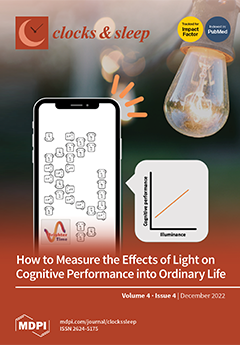Objective/Background: Phenotyping of non-rapid-eye-movement (NREM) parasomnias is currently poorly undertaken. This study aimed to determine whether there are differences phenotypically among childhood-, adolescent-, and adult-onset NREM parasomnias continuing into and presenting in adulthood. Patients/Methods: A retrospective, cohort study of patients presenting with NREM
[...] Read more.
Objective/Background: Phenotyping of non-rapid-eye-movement (NREM) parasomnias is currently poorly undertaken. This study aimed to determine whether there are differences phenotypically among childhood-, adolescent-, and adult-onset NREM parasomnias continuing into and presenting in adulthood. Patients/Methods: A retrospective, cohort study of patients presenting with NREM parasomnia between 2008 and 2019 (
n = 307) was conducted. Disorders included sleepwalking (
n = 231), night terrors (
n = 150), sexualised behaviour in sleep (
n = 50), and sleep-related eating disorder (
n = 28). Results: Compared to the adult-onset NREM behaviours group, the childhood- and adolescent-onset groups were more likely to have a family history of NREM behaviours (
p < 0.001), experience a greater spectrum of NREM disorders (
p = 0.001), and report a history of sleep-talking significantly more frequently (
p = 0.014). Atopy was most prevalent in the childhood-onset group (
p = 0.001). Those with childhood-onset NREM parasomnias were significantly more likely to arouse from N3 sleep on video polysomnography (
p = 0.0003). Psychiatric disorders were more likely to be comorbid in the adult-onset group (
p = 0.012). A history of trauma coinciding with onset of NREM behaviours was significantly more common in the childhood- and adolescent-onset groups (
p < 0.001). Conclusions: Significant differences exist across childhood-, adolescent-, and adult-onset NREM parasomnia presenting in adulthood. This study suggests that adult-onset slow-wave sleep disorders may be confounded by psychiatric disorders resulting in nocturnal sleep disruption and that unresolved traumatic life experiences perpetuate NREM disorders arising in childhood and comprise one of the strongest external risk factors for triggering and perpetuating these disorders in adolescence.
Full article






